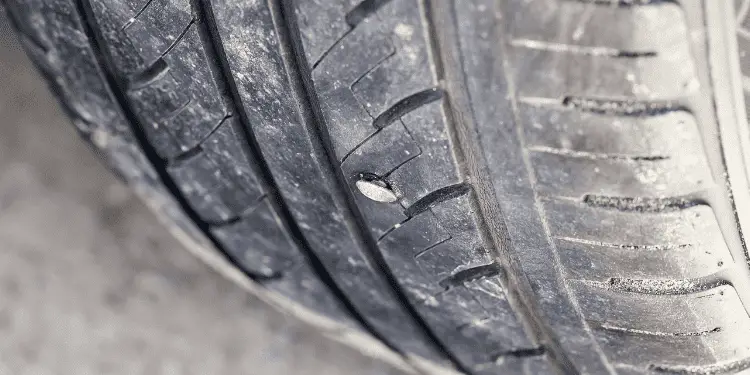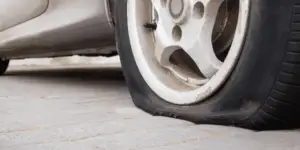You may be here because you’ve had at least one nail puncture and are looking for ways to reduce the chances of it happening again.
Nails can be thrown up by vehicles driving in front of your car or thrown across a carriageway by vehicles going in the opposite direction.
Often your front wheels will pick up a nail that is laying flat and then throw it to your rear tires, where it causes a puncture.
This is why rear end punctures are more common than front tire punctures.
Below we look at the four main ways you can prevent punctures caused by nails in the future.
Mud Flaps
As mentioned, rear tire punctures are more common than front ones.
Often a nail laying flat will be picked up by the front tire, hit the underneath chassis of your car, and then ricochet into your rear tire, sharp end first before being pushed into the rubber as your tire drives over it.
Mud flaps are a good idea for protecting your tires from nail damage.
With mud flaps, any nails picked up by the front tires should hit the mud flap before settling down flat again before your rear wheel has a chance to drive over it.
Most cars used to have them fitted to prevent mud from splashing around the wheel arch and the bodywork. Sometimes though, they get broken off, especially in older cars, and should be replaced.
Of course, this can’t be an exact science as we don’t know the size of the nail or the velocity it will hit the mud flap.
Still, it does stand to reason that any object that is settled more quickly on the road is less likely to cause damage to a tire running over it half a second or so later.
It may be best to ensure that your front wheel mud flaps are in good condition and not to concern yourself too much with the ones at the back of the car.
Having rear flaps will help your nail settlers sooner for the cars traveling behind you, but as far as protecting your car from now punches is concerned, they serve little benefit.
If your car doesn’t have mud flaps (many modern especially luxury cars don’t ) they are easy to fit, and usually require the drilling of a couple of holes in the bodywork. It is just a case of screwing the flaps on, and you’re ready to go.
There is no need to spend a lot of money on mud flaps. Most are universal and will fit on any car. Expect to pay no more than 15 to $20 per mud flap.
Run-Flat Tires
Run-flat tires are a good option if you want to avoid the hassle and interruptions of changing a flat tire. These tires have special compounds that allow them to run for limited distances after being punctured.
Apart from the convenience of not having to repair a nail punctured tire at the side of the road, run flat tires have many limitations and downsides.
The main one is the cost. Not only are run flat tires more expensive than traditional standard tires they can also not be repaired from a nail puncture in the tread.
Of course, nothing can stop an individual from patching or plugging a run flat tire, but all major reputable tire shops will not touch it as tire manufacturers do not recommend a repair.
Because run flat tires have more sturdy sidewalls to enable the car to still run when the tire is flat, this equates to a bumpy, less smooth ride as the tire can’t absorb potholes and poor road surfaces as well.
You also need to have a TPMS monitoring system installed in your car to enable you to use run flat tires on your wheels. TPMS stands for tire pressure monitoring system; without this, you can’t fit run flat tires.
The reasoning is you would be unaware that you had a damaged tire if you had a run flat unless you were warned of low tire pressure by this system.
The good news is if your car was made post-2007, it will have a TPMS system as standard by law so run flat tires are likely an option for you and your vehicle.
Puncture Prevention Tire Sealant
There are a lot of tire puncture sealant kits on the market, but not as many sealant kits that will prevent punctures from happening in the first place.
Prevention is always better than cure in life.
Puncture Prevention Tyre Sealant is a liquid you inject into your tires and is the best way to ensure you’ll never get another flat tire.

This makes it an effective tool against nails, glass shards (often embedded in the road), and larger objects such as screws and bolts.
If you decide to inject this sealant into your tires, inspecting them more frequently is always a good idea.
Preventative tire sealant is not a permanent fix but should last long enough for you to notice that your tire has been punctured when you next inspect it.
Whether you can repair a tire that has had preventative tire sealant injected into it is down to the tire manufacturer. Each will have their guidance on this.
Tire shops will always check with the tire makers’ guidelines before affecting a plug or a patch on a tire that has had preventative sealant installed within it.
Avoid Certain Neighborhoods
I’ve left this option until last because it is something that you may or may not be able to action. The truth is some roads and areas are more prone to having debris on the roads than others.
A quiet residential street is very unlikely to have much in the way of nails or screws on the road, whereas an industrial area or area under construction will have many more.
If you continually get punctures from nails and screws and you can find an alternative route that doesn’t take that much more time, this may be a cheaper alternative than continually having to replace or repair car tires.
Conclusion
There are a few ways to prevent car tires from getting punctured by nails. You can get mud flaps for your car, run-flat tires that do not need air if punctured, or preventative sealant for driving on the road with regular tires.
The fourth option is to try to avoid areas that are under construction or are heavily industrialized neighborhoods. I know, easier said than done!



![Can I Drive On A Run Flat Tire? [ANSWERED] LOW-AIR-PRESSURE-TIRE](https://carzaza.com/wp-content/uploads/2023/12/LOW-AIR-PRESSURE-TIRE-300x150.png)
![How To Avoid Nails In Tires? [ANSWERED] tire-with-screw-in-tread](https://carzaza.com/wp-content/uploads/2023/12/tire-with-screw-in-tread-300x224.png)
![How Far Can You Drive On A Rear Flat Tire? [ANSWERED] FLAT-TIRE-PARKED](https://carzaza.com/wp-content/uploads/2023/12/FLAT-TIRE-PARKED-300x150.png)







